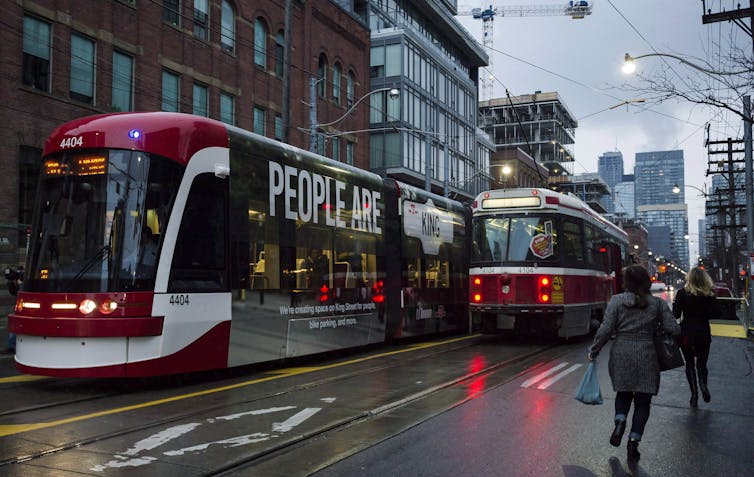
With high gas prices and climate change top of mind for many in Ontario, transportation is shaping up to be a key battleground in the upcoming provincial election.
The Progressive Conservatives have pledged $25.1 billion to highway expansion and rehabilitation if re-elected in June. The NDP platform includes a commitment to cover 50 per cent of municipal public and para-transit operating costs and to do away with public-private partnerships. Meanwhile, the Liberal party made a splash when it announced its intention to reduce public transit fares to $1 for a single trip or $40 for a monthly pass across the province until 2024.
It is rare for transportation to feature centrally in an election. As a researcher studying environmental politics and political economy, it is encouraging to see a sector responsible for the largest percentage of greenhouse gas emissions in the province feature prominently in political debate.
Indeed, mobility has always been a deeply political subject that affects almost every aspect of daily life. This is because mobility infrastructure, as political theorist Langdon Winner explains, is “a way of engineering relationships among people that, after a time, becomes just another part of the landscape.”
Mobility infrastructure includes roads, sidewalks, buses, bridges, pathways, light rail and access ramps. Mobility research tells us that the way these things are configured, maintained and governed reflects and produces particular political interests and social justice outcomes. With this in mind, it is crucial that we ask who our mobility infrastructure is for and what purpose it serves.
Car politics
Take, for example, the dominance of the automobile today, which came about through significant public subsidization of automobile infrastructure to expand private vehicle ownership. This was neither apolitical nor natural.
In fact, a significant amount of academic research suggests that state intervention in favour of automobiles reflected and helped produce an individualized, resource-intensive consumer society.
This had an immediate and lasting impact on social justice outcomes. In a study of the impacts of the Highway Act of 1956, civil rights lawyer and legal scholar Deborah Archer found that highway construction planners disproportionately targeted poor and predominantly Black communities. The effect was to “symbolically and physically encourage racial segregation.”
The economic and health impacts of demolishing homes and businesses in favour of highways in these communities endure today.
Uneven access to mobility has proven challenging to undo. Much of the car-centric mobility infrastructure built in the postwar era is still with us or has expanded.
In Canada, cities have been designed around the movement of cars. Vast areas have been paved and residential areas have been built close to high-volume roads, contributing to poor health outcomes related to pollution and excessive summertime heat. Low-income areas are disproportionately affected.
Infrastructure is political
In recent years, research has expanded our understanding of these dynamics and linked them to the role of infrastructure development in settler-colonialism, racial capitalism and patriarchy.

Infrastructure in Indigenous communities is chronically underfunded. Many remote northern communities rely on temporary ice roads to access southern municipalities in the winter, and these ice roads are becoming less reliable due to climate change. For those with all-year road access, the reduction of Greyhound bus routes in 2018, followed by the end of the company’s operations in 2021, cut off many Indigenous communities from urban centres and the family, employment, health and other services located there.
Read more: Indigenous communities should dictate how $1 billion infrastructure investment is spent
Indeed, the National Inquiry into Missing and Murdered Indigenous Women and Girls, found that the “lack of supportive infrastructure and transportation” created significant risk.
The pandemic’s effects
The pandemic has only served to further heighten and highlight transportation safety issues. Since the onset of COVID-19 in 2020, we have seen how the mobility of public transit users and those who walk or wheel for transportation has been negatively impacted by diminished service and maintenance.
Data from the United States also suggests pedestrian injuries and deaths, which have been on the rise for a decade, spiked during the pandemic.
We know too that transportation-related injuries are not evenly distributed, with Indigenous and racialized peoples and those in low-income areas being much more likely to be injured or killed.
Just and equitable access to mobility
This raises important questions about how to make sure our mobility infrastructure is accessible, safe, equitable and sustainable. We need to ensure that infrastructure investment is not solely aimed at spurring capitalist growth, as many have called for, but serves the needs of all its users.

In this sense, we need to ask what vision for the future our leaders, like those vying for political office in Ontario, have for mobility. But, more importantly, we need to recognize that the changes required to create a just and sustainable transportation system cannot be achieved in a single election but only through systemic, structural changes in how we think about, govern and build mobility.
Toward this aim, researchers and activists — like those at The Untokening, a collective focused on mobility justice — have advanced the concept of mobility justice as a “social movement to protect and reclaim the shared mobility commons.” Mobility commons, according to sociologist Mimi Sheller, are “co-operative” and “shared infrastructures of movement,” in contrast to the enclosed, private and exclusionary systems that are dominant today.
There are many movements currently working to increase access to shared, collective forms of transportation. These include movements calling for fare-free transit, to reduce the policing of mobility, disability transportation equity, better sidewalk maintenance and a public intercity bus service among others.
Mobility justice can only be achieved by taking the politics of movement seriously. This means planning processes must not only listen to, but meaningfully include and be governed by the communities that will use the infrastructure.
It means remaking mobility systems so that they are democratically controlled, equitably distributed and accessible to all.
Joshua K. McEvoy volunteers with Free Transit Ottawa.
This article was originally published on The Conversation. Read the original article.







